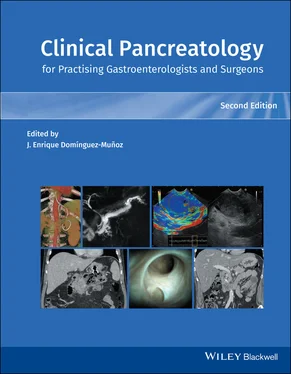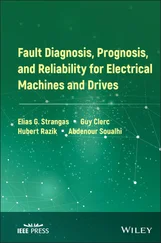13 Section VI: Cystic Tumors of the Pancreas 70 Histological Classification of Pancreatic Cystic Neoplasms Introduction Serous Cystic Neoplasm Mucinous Cystic Neoplasm Intraductal Papillary Mucinous Neoplasm Intraductal Oncocytic Papillary Neoplasm Intraductal Tubulopapillary Neoplasm Solid Pseudopapillary Neoplasm References 71 Role of Endoscopic Ultrasound and Endoscopic Ultrasound‐associated Techniques in the Diagnosis and Differential Diagnosis of Pancreatic Cystic Tumors Introduction EUS Imaging EUS‐FNA EUS‐guided Through‐the‐needle Imaging EUS‐guided Through‐the‐needle Biopsy Summary References 72 The Role of Multidetector CT, MRI and MRCP in the Diagnosis and Differential Diagnosis of Pancreatic Cystic Neoplasms Introduction CT Technique MRI Technique Cystic Pancreatic Masses Other Cystic Pancreatic Lesions Conclusion References 73 Intraductal Papillary Mucinous Neoplasm Introduction Clinical Considerations IPMN Guidelines Reconciling the Differences Surveillance Strategy for IPMNS not Meeting Criteria for Resection Optimal Surgical Approach Long‐term Follow‐up after Surgical Resection Conclusions References 74 Cystic Tumors Other than IPMN Introduction Scope of Pancreatic Cystic Neoplasia Mucinous Cystic Neoplasm Serous Cystic Neoplasm Solid Pseudopapillary Neoplasm Cystic Pancreatic Endocrine Neoplasm Other Rare Cystic Neoplasms References 75 Pancreatic Cystic Tumors: any Role for Local Therapies? Introduction Indications for EUS‐guided Ablation Therapy EUS‐guided Therapy Conclusions References
14 Section VII: Neuroendocrine and Other Tumors of the Pancreas 76 Diagnosis and Treatment of Pancreatic Neuroendocrine Tumors Introduction Clinical Presentation Diagnosis Staging Systems Treatment Acknowledgments References 77 Other less Frequent Pancreatic Tumors Acinar Cell Carcinoma of Pancreas Hepatoid Carcinoma of Pancreas Schwannoma of Pancreas Perivascular Epithelial Cell Tumor of Pancreas Hematological Malignancies of Pancreas Primary Leiomyoma of Pancreas Primary Leiomyosarcoma of Pancreas Pancreatic Lipoma Pancreatic Liposarcoma Cystic Lymphangioma of Pancreas Squamous‐lined Cyst of Pancreas Adult Pancreatoblastoma Pancreatic Metastasis from Other Tumors References
15 Section VIII: Functional Alterations of the Pancreas in Other Clinical Situations 78 Diagnosis and Therapy of Exocrine Pancreatic Insufficiency after Gastric and Pancreatic Surgery Introduction Gastrectomy Pancreatectomy References 79 Pancreatic Exocrine Insufficiency in Type 1 and Type 2 Diabetes Mellitus Historical Aspects of Pancreatic Diseases and Diabetes Mellitus [1,2] Pancreatic Exocrine Function in Patients with Diabetes Mellitus Pancreas Morphology in Patients with Diabetes Mellitus Pathophysiological Concepts of Altered Exocrine Pancreas Morphology and Function in Type 1 and Type 2 Diabetes Mellitus Clinical Impact of Exocrine Disease in Type 1 and Type 2 Diabetes Mellitus Conclusion References 80 Diabetes Mellitus Related to Diseases of the Exocrine Pancreas (Pancreatogenic Diabetes) Introduction Epidemiology Diagnosis Treatment Knowledge Gaps Conclusions Acknowledgments References
16 Index
17 End User License Agreement
1 Chapter 1 Table 1.1 ABC causes of acute pancreatitis. Table 1.2 Indications for genetic testing in patients with acute pancreatitis... Table 1.3 Drugs commonly associated with acute pancreatitis. Table 1.4 Classification of acute pancreatitis. Table 1.5 Predictors of severe acute pancreatitis. Table 1.6 Fluid therapy for patients with moderately severe or severe acute p... Table 1.7 Factors associated with increased readmission rates. Table 1.8 Long‐term sequelae after resolution of acute pancreatitis.
2 Chapter 2 Table 2.1 Causes of acute pancreatitis. Table 2.2 Frequency of biliary microlithiasis in recurrent acute pancreatitis... Table 2.3 Independent risk factors for post‐ERCP pancreatitis.
3 Chapter 3 Table 3.1 Comparison of Atlanta Classification, Revised Atlanta Classificatio... Table 3.2 Modified Marshall scoring system.
4 Chapter 4 Table 4.1 Existing scoring systems for prediction of severe pancreatitis. Table 4.2 Cytokines, chemokines, and adipokines examined in studies for predi... Table 4.3 Components of computed tomography severity index (CTSI) and modifie...
5 Chapter 5 Table 5.1 CT prognostic scoring systems.
6 Chapter 6 Table 6.1 MRI protocol for evaluating acute or chronic pancreatitis.
7 Chapter 7 Table 7.1 Clinical findings associated with a severe course for initial risk ...
8 Chapter 8 Table 8.1 Modified Marshall scoring system for organ dysfunction.
9 Chapter 9 Table 9.1 Intravenous administration of analgesics. Table 9.2 Epidural administration of local anesthetics and opioids.
10 Chapter 11 Table 11.1 Oral refeeding protocols after acute pancreatitis. Table 11.2 Characteristics of studies included in systematic review.
11 Chapter 17 Table 17.1 Revised definitions of morphological features of acute pancreatiti...
12 Chapter 20Table 20.1 Causes of recurrent acute pancreatitis.Table 20.2 Stratification of recurrent acute pancreatitis based on risk of pr...
13 Chapter 21Table 21.1 Overview of direct and indirect pancreatic function tests.
14 Chapter 22Table 22.1 Causes of chronic asymptomatic hyperamylasemia.
15 Chapter 23Table 23.1 TIGAR‐O Version 2 risk/etiology classification: short form.
16 Chapter 25Table 25.1 Individual susceptibility to alcoholic pancreatitis.
17 Chapter 26Table 26.1 Genes that should be screened for in patients with CP of unknown e...Table 26.2 Mutations most likely to be expected in CP patients when screening...
18 Chapter 27Table 27.1 Potential obstructive causes of chronic pancreatitis.Table 27.2 Summary and recommendations for clinical practice.Table 27.3 Endoscopic therapy in pancreatitis and pancreas divisum: systemati...Table 27.4 CFTR mutation frequency is higher in pancreatitis patients with PD com...
19 Chapter 28Table 28.1 Cambridge classification for transabdominal ultrasound.Table 28.2 Cambridge classification for EUS.Table 28.3 Cambridge classification for CT and MRI.
20 Chapter 29Table 29.1 Imaging findings of different types of chronic pancreatitis.
21 Chapter 30Table 30.1 MRI/MRCP findings in chronic pancreatitis.Table 30.2 MRI/MRCP findings of CP complications.
22 Chapter 31Table 31.1 EUS criteria for CP defined by the minimum standard terminology an...Table 31.2 Number of EUS criteria needed for the diagnosis of CP in studies u...Table 31.3 Consensus‐based parenchymal and ductal features of CP according to...Table 31.4 EUS diagnosis of chronic pancreatitis (CP) based on Rosemont conse...
23 Chapter 32Table 32.1 Causes of pancreatic insufficiency.Table 32.2 Description of direct and indirect pancreatic function tests.Table 32.3 Descriptive protocol of two endoscopic pancreatic function tests (...
24 Chapter 33Table 33.1 Accuracy (range reported in the literature) of currently available...Table 33.2 Severity of the reduction of stimulated pancreatic secretion durin...
25 Chapter 34Table 34.1 Consequences of exocrine pancreatic insufficiency.Table 34.2 Protocol for the approach to patients with CP.
26 Chapter 35Table 35.1 Summary of characteristics of QOL questionnaires used in assessmen...Table 35.2 Comparison of two chronic pancreatitis‐specific QOL questionnaires...
27 Chapter 36Table 36.1 Main reasons for pain in chronic pancreatitis.Table 36.2 Recommended oral analgesics for pain management in chronic pancrea...
28 Chapter 38Table 38.1 Clinical manifestations of pancreatic exocrine insufficiency.Table 38.2 Main differential diagnoses of pancreatic exocrine insufficiency.Table 38.3 Tests used for the diagnosis of pancreatic exocrine insufficiency.
29 Chapter 39Table 39.1 Surgical interventions for pain in chronic pancreatitis.
Читать дальше












